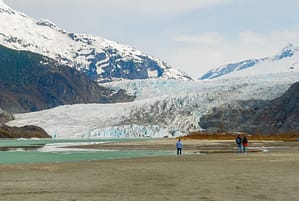Last week, Swiss public television presented a series of comprehensive reports on the evolution of glaciers on its regional channels RTS and RSI.
For a week, the French-speaking channel RTS gave the floor to teenagers in its series “Au temps des glaciers” (journalists: Laurent Dufour, Flore Dussey, Elisa Casciaro). Successively exploring the Plaine-Morte Glacier (in Crans-Montana, Valais), the Mont-Blanc Glacier (in neighbouring France), the Bosadino Glacier (in Val Bosino, Ticino) and the Morteratsch Glacier (in Graubunden), these young people accompanied scientists and glaciologists. Curiosity and concern were constantly recurring in conversations: can we successfully stop the melting of glaciers? Should we limit tourism? What kind of biodiversity will appear once the ice melts?
The work of two photographers was also presented. David Carlier seeks to highlight the graphic aspect of the Eggishorn Glacier located at the bend of the Aletsch glacier: “I feel that I have a responsibility to show, to document this heritage as it is today. My commitment also goes to the recognition of this beauty.”
Laurence Piaget-Dubuis, on the other hand, decided to photograph the tarpaulins that protect against melting rather than portraying the beauty of the Rhone Glacier itself. For her, these white blankets “remind us of the tents in migrant camps“.
The Italian-speaking channel RSI highlighted the Svalbard glaciers in a series of reports entitled “La febbre alta del Polo Nord” (journalists: Gilberto Mastromatteo and Paolo Martino). Svalbard is an archipelago of islands belonging to Norway, which is just over a thousand kilometers from the geographical North Pole.
The various programs independently from each other also reported on an avalanche that formed in response to the heat in the summer of 2015 that killed two people in Longyearbyen (the northernmost city in the world); the Global Seed Vault, which contains a copy of the seeds kept in the genetic banks of the world – now these are jeopardized because the permafrost that can keep the seeds alive for decades is itself a victim of the effects of global warming ; the Polar Permaculture, which is the northernmost greenhouse in the world (invented by Benjamin Vidmar to produce food at the North Pole); and lastly the approximately three thousand polar bears, marine species, birds, foxes and reindeer that are now all endangered.




One Response
Interesting facts and television reports, Timothy. It’s a pitty that we can’t receive those here in Holland! Nevertheless thank you for posting this, it confirms the necessity and right to exist of Recogn’ice! Kind regards, Marita
Comments are closed.